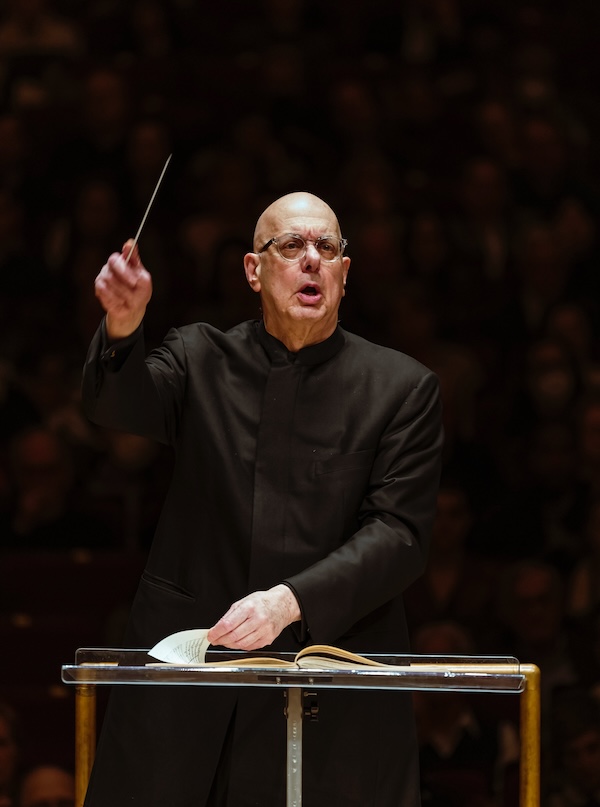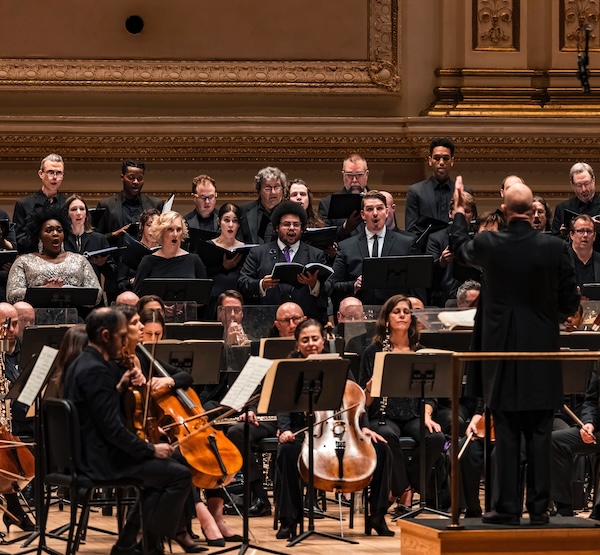Botstein, ASO and soloists soar in Dvořák’s Requiem at Carnegie Hall

Leon Botstein, conductor of the American Symphony Orchestra, writes in the program that he is puzzled as to why Dvořák’s Requiem is so infrequently heard.
With Thursday evening’s performance at Carnegie Hall he made the best possible case for the work by leading the ASO, Bard Festival Chorus, and four superb soloists—soprano Leah Hawkins, mezzo-soprano Lindsay Ammann , tenor Joshua Blue, and bass Stefan Egerstrom—in a moving performance of what is truly an unjustly neglected choral masterwork.
Unlike the Stabat Mater, which Dvořák began after the death of his two-year-old daughter in 1875 and would finish after the those of his two surviving children in 1877, the Requiem was not inspired by overwhelming personal tragedies. Rather, it was the product of a commission from the Birmingham Music Festival in England. The suggestion of fulfilling it with a setting of the requiem text came from the composer’s London publisher Alfred Littleton. Dvořák conducted the first performance of the work at the festival in 1891, where it was an unqualified success.
Undoubtedly Dvořák was familiar with other composer’s settings of the Catholic Mass for the Dead, but musicologists suggest that his model was Cherubini’s Requiem in C minor from 1816, which was one of the most popular choral works of the nineteenth century. There are passages which bring to mind the Verdi Requiem, and the great fugal passages likewise evoke those in Brahms’s Ein deutsches Requiem.
The four soloists which Botstein assembled could hardly have been better. Their blend as a quartet was impressive, and the interplay with chorus and orchestra was just as adroit. One of the most moving moments of the performance was the trio of Ammann, Blue and Egerstrom singing with the altos and tenors and basses of the chorus in the Pie Jesu. This unusual mix of timbres added a special poignancy to this prayer that eternal rest be granted to the departed. Another such movement was the entire quartet singing the words “quia pius es” in the Agnus Dei.

Hawkins, who had helped open the Metropolitan Opera’s season as the soprano soloist in the Verdi Requiem, was in splendid form. Her sumptuous voice blazed through chorus and orchestra in the openingRequiem aeternum. Perhaps more stunning, however, was the delicacy and sensitivity with which she sang with the women of the chorus in the Graduale. In the concluding Agnus Dei, Hawkins’s pleas that the departed be granted eternal life were as beautiful as they were moving.
Dvořák lavished some of the piece’s most exciting passages on the tenor soloist and Joshua Blue sang them brilliantly. His opening proclamation of Te decit Hymnus rang forth free and clear. His interplay with the oboe in the Tuba mirum was particularly satisfying musically and emotionally. He topped off the section with a heroic outburst of glorious tenor sound.
Mezzo-soprano Lindsay Ammann’s wonderful ruby-colored voice of exceptional depth lent natural drama to everything she sang. Her voice rang majestically in the Tuba mirum when summoning the dead on day of judgement. Ammann’s voice also blended perfectly with that of the fine young bass Stefan Egerstrom. Their duet in the Lacrimosa to harp accompaniment was exceptionally moving.
Egerstrom’s voice was the anchor of this performance due to its strength and resonance of its lower range. His solo passages in the Tuba mirum, the Lacrimosa, and the Sanctus were particularly impressive. When rock-solid low notes were required, Egerstrom never disappointed.
Dvořák set some of the most vivid texts, whether reflective or turbulent, for the chorus. The Bard Festival Chorale conjured the drama and the emotion with vibrant sound and keen musicianship. They thundered en masse in the Confutatis maledictis and delivered a slam-bang ending to the joyous final measures of the Sanctus. The great fugues which conclude the Offertorium and the Hostias were sung with precision, power, and passion. Most impressive were the many a capella passages which were sung perfectly in tune.
Underpinning the efforts of soloists and chorus was the equally fine performance by the ASO under Botstein’s direction. In painting the emotions of the text, Dvořák demonstrated his command of creating vivid orchestral colors. Many of the subtle passages are given to the woodwinds, particularly the solo flute, which were played with great sensitivity. Rich cello sound coursed through the entire work.
For glorious, often terrifying, outbursts, Dvořák like every other composer turned to the brass and tympani. They were splendidly loud and horrifying in the Dies Irae, while the brass on their own added a particular poignancy to the Lacrimosa. The Requiem ended with Botstein drawing soft, transparent sound from the orchestra alone. In these final measures, as throughout the entire performance, he showed his deep understanding and mastery of the work.
The ASO returns to Carnegie Hall with Schoenberg’s Gurre-Lieder on March 22. americansymphony.org